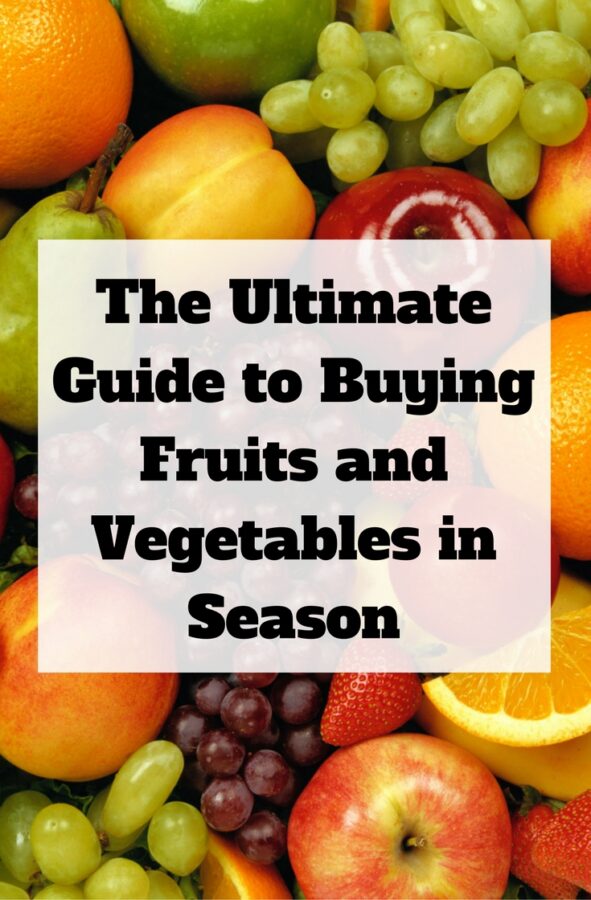
My mother taught me that prices at the store can vary widely, depending on the time of the year. She told me it was best to buy produce in season when they are cheapest and freshest. I follow her advice when grocery shopping since I want my family to enjoy meals that are delicious, healthy, and affordable. What I discovered is that there are fruits and vegetables available for each month and season of the year. Here's a list I came up with for the best times to buy fruits and vegetables.
This guide is quite long, so we provided anchor links to help you jump to sections that interest you. You can also choose to read this article chronologically.
Winter
Spring
Summer
Fall
For more variety, I also included items that are not very popular but still meet my criteria for flavor, nutrition, and budget. There's also a recipe for each month featuring the fruits and vegetables in the list. So what's fresh and affordable each month?
Winter
Depending on where you live, the winter months can be the most difficult time to find fresh produce. As a little girl, I remember certain things being luxuries in January but becoming staples in July, and vice versa. After researching this article, I no longer need to wonder, and I hope you won't either.
December Fruits and Vegetables
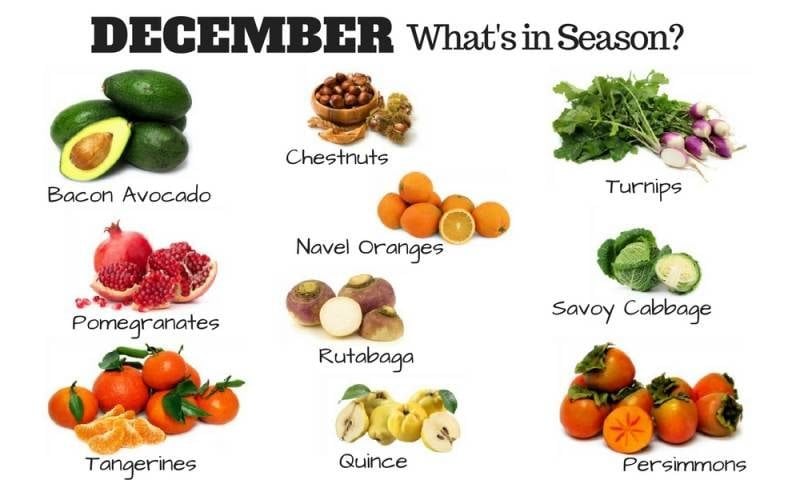
-
Tangerines
We think of fruit as being a “summer” item. It's rather surprising to find that there are many fruits which are harvested in the winter months. Tangerines are one such fruit, reaching their peak in December.
-
Chestnuts
“Chestnuts roasting on an open fire, Jack Frost nipping at your nose…” Not just pretty words, it turns out: chestnuts reach their peak in the festive month of December.
-
Persimmons
Also called “the Fruit of the Gods,” these delicious fruits reach their peak in the winter months. Golden and delicious, they'll bring a taste of summer to the bleakness of December.
-
Bacon Avocado
Wait, bacon avocado? Sadly, it's not a bacon-flavored avocado; it was just named for the person who invented this variety. It is a sweet, creamy avocado that makes an excellent salad dressing and is ready to harvest in December.
-
Navel Oranges
Known as the “eating orange,” these delicious specimens are perfect as a snack or in a salad. Navel oranges are ripe in December.
-
Quince
An ancient fruit recorded as far back as the time of the Roman empire, this seemingly strange fruit is a delicacy in hiding. Able to withstand extremely cold temperatures, these fruits are best harvested in December.
-
Turnips
One of the oldest domesticated vegetables, turnips are a staple in many European diets. As a winter harvest, they make an excellent soup to warm the cold nights.
-
Savoy Cabbage
Cabbage is a hearty vegetable in itself, and the savoy breed is especially hearty as a December crop. Extremely versatile, you can make salads, chips, or even soup with this produce.
-
Pomegranates
According to Greek Mythology, this sweet red fruit is the very fruit Persephone ate, trapping herself in the underworld for half of each year, the half we call winter. How fitting, then, that this fruit should be at its peak in December.
-
Rutabaga
Although they resemble turnips, rutabagas are a much tastier vegetable. I personally prefer them mashed like potatoes, but they taste quite good roasted, too.
December
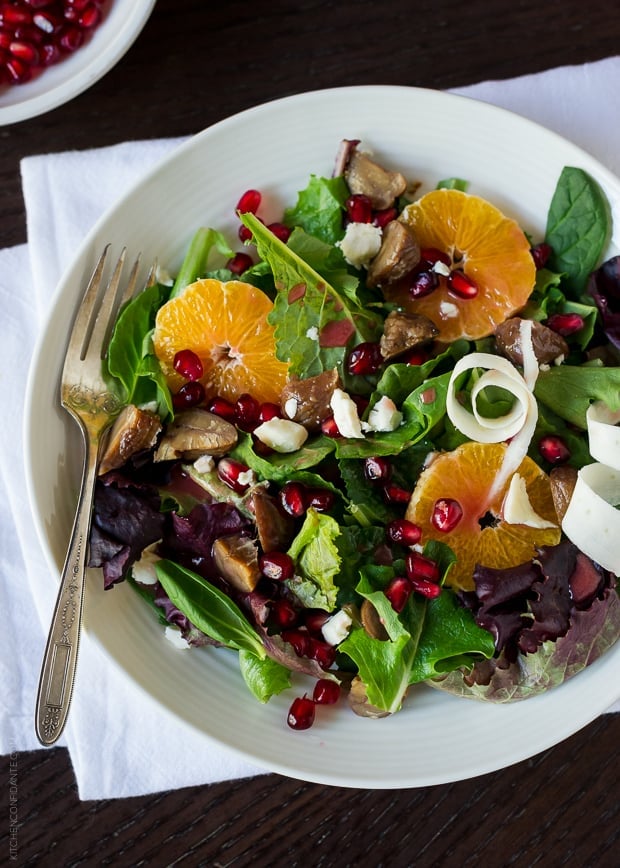
Shopping Tips
- If you're lucky enough to live somewhere farmer's markets are a year-round thing, buying at the end of the day can save you a ton of money as stalls try to get rid of their produce before they leave.
- Watch your local store sales. Most grocery stores now have apps that will help you keep track of coupons, sales, and more. Utilize those to help you save the most money on fresh produce.
- Get the most out of your produce—make sure you are storing them properly.
Click here to go back to the top and see the list of anchor links.
January Fruits and Vegetables
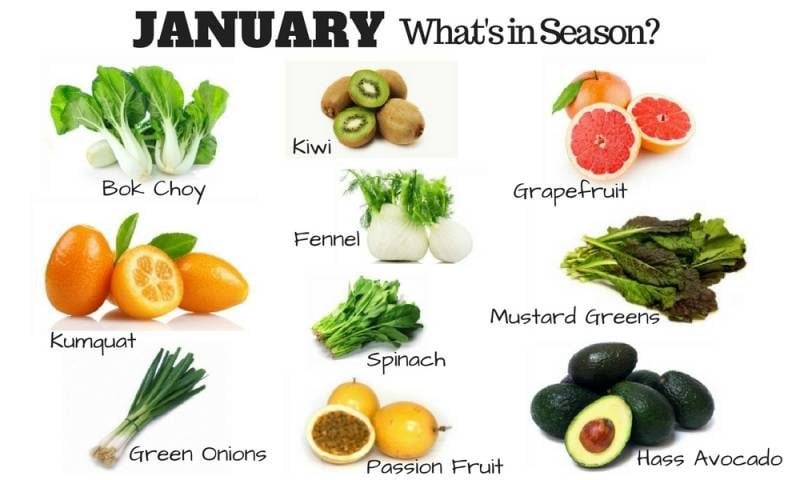
-
Spinach
One of my favorite greens, spinach makes an excellent salad. You can also add it to many dishes. This crisp vegetable is quite hardy and it is able to survive the dark, cold winters.
-
Green Onions
An excellent seasoning for many savory dishes, green onions are a crop which comes into season in January. Throw them into a salad with some spinach and have yourself a taste of summer in the New Year!
-
Mustard Greens
A popular veggie in the South, mustard greens reach the peak of their season in January. I love mustard greens cooked with ham steak and black eyed peas, a dish my grandmother used to make every New Year's.
-
Bok Choy
An excellent addition to stir-fry, bok choy is an Asian vegetable hardy enough to survive the cold snaps of winter.
-
Hass Avocado
I may have a slight obsession with avocado. They're a great addition to smoothies, and different varieties are fresh throughout the year. The Hass avocado is newly in season in January and makes a great guacamole.
-
Grapefruit
These tangy, juicy citrus fruits are an excellent breakfast option. A bite of these in January will send your taste buds on a pleasant vacation straight to a tropical beach.
-
Kiwi
Kiwi is a fairly hardy fruit that comes into season at various points in the year, and January is one of those times. Green like spring, kiwi is an excellent addition to any fruit salad.
-
Passion Fruit
As with kiwi, passion fruit tends to come into season throughout the year. One of those times is January, and let's be honest—anything sweet, fresh, and delicious in January is more than welcome!
-
Fennel
I'm not the biggest fan of fennel myself; I've never cared for licorice, and the taste of fennel reminds me of it. However, it does go well with salads, roasted meats, and such.
-
Kumquat
Interestingly, the name of this Asian fruit means, roughly, “gold orange” in China, making its festival in Dade City, Florida all the more appropriate. These odd-looking fruits are meant to be eaten whole, but also make an excellent preserve.
January
Shopping Tips
- When you buy bok choy, make sure you look for firm, white stalks and dark, crisp greens.
- Spinach stems should be thin, so avoid any that aren't.
- Kumquats have delicate skins and bruise easily, so be sure to examine each fruit closely before buying.
Click here to go back to the top and see the list of anchor links.
February Fruits and Vegetables
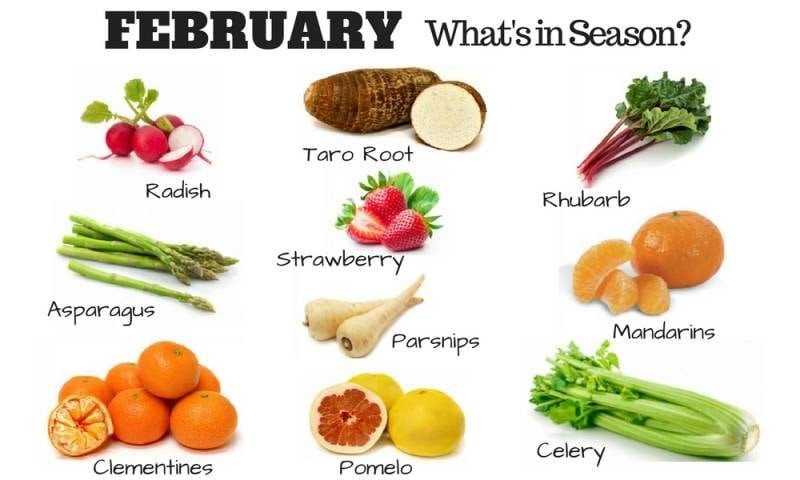
-
Clementines
Seedless, juicy, and sweet, these citrus fruits come into season just in the nick of time. They are the perfect on-the-go snacks for kids.
-
Asparagus
Asparagus comes into season in February, lasting well into the spring and early summer.
-
Celery
One of my children's favorite snacks is Ants-on-a-Log, the classic celery stick with peanut butter and raisins. Now I know when to get celery at its freshest for this healthy snack.
-
Radish
Although I've never cared for radishes myself, after researching this list and learning of the many benefits radishes have to offer, I may have to rethink that come February.
-
Taro Root
To be honest, this is one vegetable I'd never even heard of before. Taro root is, as the name implies, a root vegetable which is popular in Japanese cooking. It is usually harvested in February.
-
Parsnips
Although they look suspiciously like carrots, this root vegetable has a texture and flavor all its own. A biennial plant, parsnips are perfect in stews. They are available from February through early summer.
-
Strawberry
Did you know that strawberries are not actually berries? No matter what they are, these popular red fruits always marked the coming of spring when I was little. They grow best during months with cool nights and warm days, like February.
-
Rhubarb
Rhubarb grew in patches around my childhood home, and I remember picking the plant to eat raw while wandering the woods with my siblings. February is when this tart fruit begins to show up, and you can bet I'll be first in line to buy it all up.
-
Mandarins
As winter gives way to spring, citrus fruits are an excellent source of vitamin C after those long, sunless days. Mandarins are ready for harvest in February. They make an excellent addition to fruit smoothies.
-
Pomelo
Another excellent citrus too often overlooked, this cousin of the grapefruit is less tart than its more popular counterpart. It makes for an amazing substitute in all kinds of citrus-based recipes.
February
Shopping Tips
- Citrus fruits freeze well, so take advantage of this by freezing any unused fruits before they go bad.
- Don't wash rhubarb until you are ready to use it!
- Produce is often sprayed with a light mist of water in the refrigerated section – this can actually make your produce heavier and cost you more, so shake it off before you bag it.
Click here to go back to the top and see the list of anchor links.
Spring
Spring: the harbinger of summer, the promise of adventure and sunshine. In northern states, the snow begins to melt and leaves begin to blossom on trees again. As the cold of winter slowly disappears, you begin to have more choices for fresh produce.
March Fruits and Vegetables
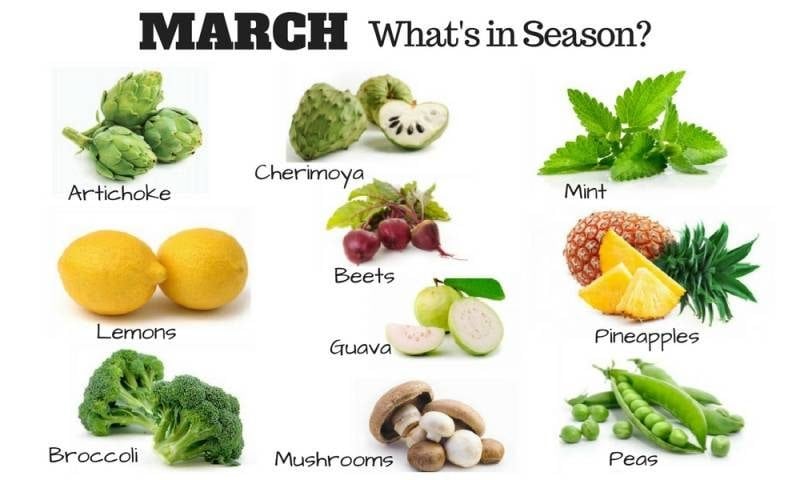
-
Artichoke
Artichokes look like little grenades and they are quite versatile. Dips, stews, seafood dishes, and more are complemented by this Mediterranean native. What better cuisine to welcome the end of winter than a taste of the Mediterranean?
-
Broccoli
A favorite side dish, broccoli is chock full of the vitamin C we're all lacking come spring. No wonder it's fresh in March!
-
Beets
Available throughout the year in various climates, March is an excellent time for beets in most regions.
-
Mushrooms
Technically fungi, mushrooms first start showing up as the snow leaves the ground in March.
-
Peas
What type of peas you get depends on what time of year you harvest them. Peas harvested in March, when it's still chilly outside, aren't as sweet as peas from later harvests, but still just as yummy!
-
Mint
Technically an herb, mint is a pretty traditional spring flavor. From mint jelly to mint Girl Scout cookies, this March plant is a favorite worldwide.
-
Cherimoya
An ancient fruit which is tricky to grow and produce, the cherimoya is well worth the struggle. Eaten raw or baked in a pie, make the most of this creamy fruit by buying at the start of the season.
-
Pineapples
Although this popular fruit can be found throughout the year, pineapples are at their peak from March to July.
-
Guava
Guava is a popular fruit for smoothies, juices, jellies, and more. Requiring a tropical climate to grow, it can be found in season from March onward through the warmest months of the year.
-
Lemons
Yet another citrus fruit finds its way onto our list. As yellow as the sunshine breaking through the winter skies, lemons are a hardy fruit popular for its tangy juices.
March Recipe
Sunny Citrus Smoothie by @wholefoods
Image source: wholefoodsmarket.com
Shopping Tips
- Choose broccoli with green heads and tightly packed florets.
- To make sure your lemon isn't a, well, a lemon, select ones that are heavy and have shiny skin.
- Store loose mushrooms in a paper bag or a damp cloth bag in the fridge.
Click here to go back to the top and see the list of anchor links.
April Fruits and Vegetables
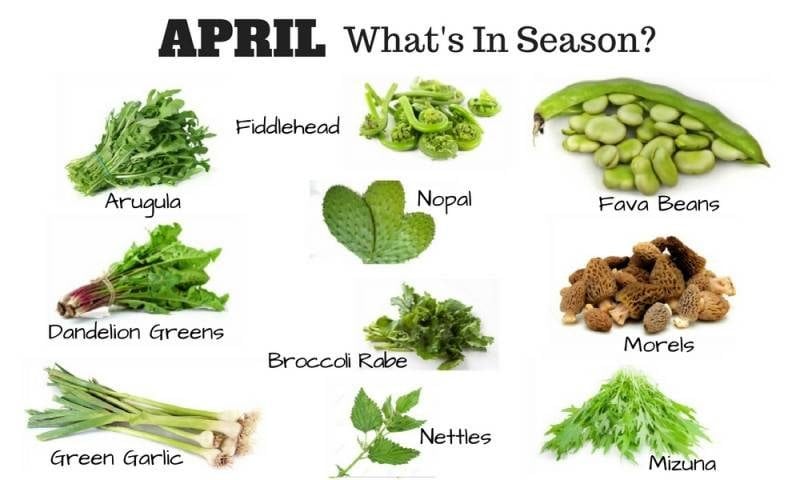
-
Fava Beans
If you're as much of a fan of Mediterranean food as my family is, you're probably familiar with the little green gems known as fava beans. Also popular among Middle Eastern cuisine, these legumes come into season in April. They are an excellent side dish for lamb.
-
Mizuna
A Japanese green, mizuna is commonly found in baby lettuce mixes. Coming into season in April, mizuna would make a tasty addition to your next salad.
-
Broccoli Rabe
Contrary to what the name of this vegetable may have you thinking, broccoli rabe is actually more closely related to the turnip than it is to broccoli. At its peak during this time, broccoli rabe is best prepared similarly to mustard greens.
-
Fiddlehead
Named for its appearance, which puts many in mind of the end of a violin, fiddleheads are immature ferns. Appearing in early spring, they taste similar to green beans.
-
Morels
Not to be confused with life's guiding principles (morals), morels are a species of edible mushrooms which have a honeycomb appearance. Like other mushrooms, they begin making an appearance in the spring months.
-
Nettles
Nettles get a bad rep as an itchy weed, but don't write them off the menu just yet. Packed full of nutrients, this spring treat will add a rich, earthy flavor to any soup or stew dish.
-
Arugula
Upon finding out that arugula is also called the rocket plant, my son promptly begged me to buy as much as I could. So, parents, good news! Just tell them these nutritional, peppery greens are rockets and they'll eat them up.
-
Dandelion Greens
Dandelions are more than just a bright yellow flower, it turns out. Their leaves make a sweet addition to your favorite spring salads, which coincides perfectly with their peak.
-
Green Garlic
Green garlic is the young garlic that appears in early spring, before the buds we're more familiar with show up. With a less spicy flavor than its more common counterpart, green garlic can be used raw or cooked.
-
Nopal
Found on the prickly pear cactus, nopales are popular in Mexican cuisine. Making an appearance in April, the nopal is very similar to okra.
April
Shopping Tips
- When you buy fiddleheads, look for a tight coil and only an inch or so of stem.
- Wrap green garlic in a damp cloth and place in a plastic bag in the refrigerator to store.
- Although fresh is always best, buying frozen produce can often save money, as is the case with artichokes.
Click here to go back to the top and see the list of anchor links.
May Fruits and Vegetables
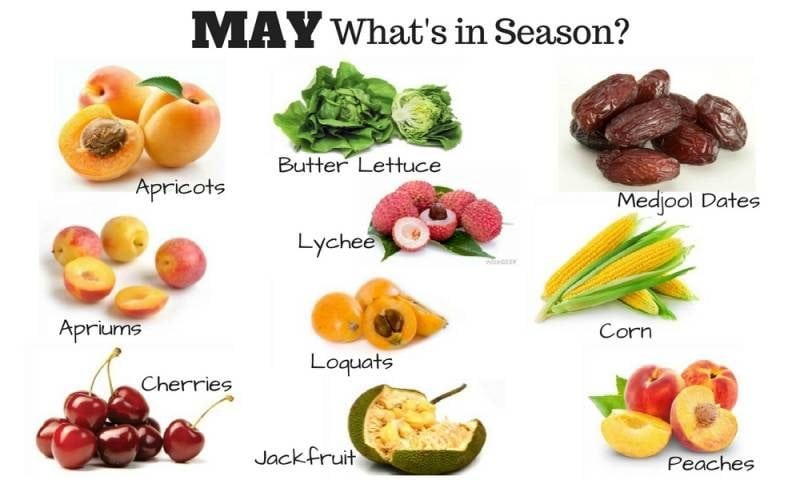
-
Apriums
A plum and apricot cross, apriums are very sweet. Only available from specialty growers, apriums make a wonderful spring snack.
-
Loquats
Once described as being what would happen if you cross a mango and an apricot, these fruits are often quite tart. Be careful to remove the seeds. Just like apple seeds, loquat seeds have toxins.
-
Butter Lettuce
Also known as Bibb or Boston lettuce, this spring lettuce has a sweet flavor that makes for an excellent pairing with a vinaigrette dressing.
-
Corn
Starting in May, corn is in season! I love corn, with just a little bit of butter and dill weed.
-
Medjool Dates
A fruit of Middle Eastern and North African origin, Medjool dates are best eaten fresh, as opposed to the dried dates most of the world is used to. With a rich, caramel-like taste, these fruits are harvested throughout the spring.
-
Apricots
Although apricots can be found in canned or dried form throughout the year, they are fresh in spring.
-
Jackfruit
Although popular in Asian countries, this fruit has only just started to make its way west, with few specialty markets carrying it. If you can find it, though, it's well worth the search.
-
Lychee
It would seem Asian fruits are partial to this time of year for blooming. Lychee is a soft fruit and the only one of its kind.
-
Cherries
Cherry ripe, cherry ripe, ripe, ripe, ripe… This popular fruit starts ripening in the early spring months.
-
Peaches
Peaches have a very short season, ending in May.
May

Shopping Tips
- Make sure you wash your butter lettuce and wrap it in paper towels before storing in the fridge.
- The best way to save money on ethnic foods like Medjool dates is to shop in your local ethnic markets.
- Peaches are best when they're just ripe, so be sure to squeeze test them before you buy.
Click here to go back to the top and see the list of anchor links.
Summer
Summer is always my favorite time of year. Most of my favorite fruits and veggies are finally in season, especially berries! The fruits and vegetables listed here are probably more familiar to you, compared with the other seasons.
June Fruits and Vegetables
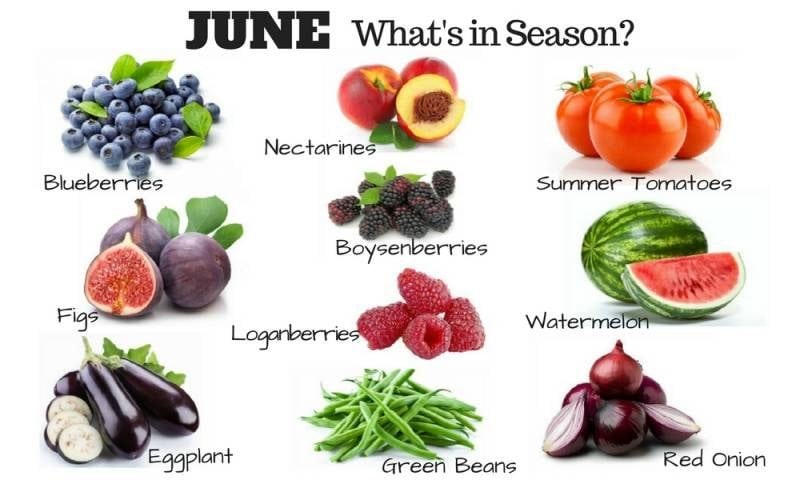
-
Figs
This sweet treat is available during the summer months, with its season starting in June.
-
Eggplant
An acquired taste, eggplant is available at its freshest starting in June.
-
Summer Tomatoes
I love tomatoes in salads, sauces, or sliced with a little salt and pepper. Yum! The best time to get them fresh is in June.
-
Red Onion
Red onions are a savory addition to many dishes. They are in season during the summer.
-
Green Beans
Delicious straight from the source, green beans reach their season at the beginning of summer.
-
Loganberries
A hybrid of blackberry and raspberry developed in 1880, loganberries are only available two months of the year, starting in June.
-
Boysenberries
The symbol of Knott's Berry Farm, the boysenberry reaches its season in June.
-
Blueberries
One of the few berries native to North America, the popular blueberry reaches season during the early summer months.
-
Nectarines
Closely related to peaches, nectarines are available in the summer months, with their season beginning in June.
-
Watermelon
Every year in June, my area has a watermelon festival. No wonder, as this refreshing treat reaches the peak of its harvest season this month.
June Recipe
Shopping Tips
- Avoid eggplants that are soft, wrinkled, or discolored.
- Tomatoes are an easy-to-grow plant and ideal for novice gardeners.
- To get the best nectarines, look for bold, bright colors.
Click here to go back to the top and see the list of anchor links.
July Fruits and Vegetables
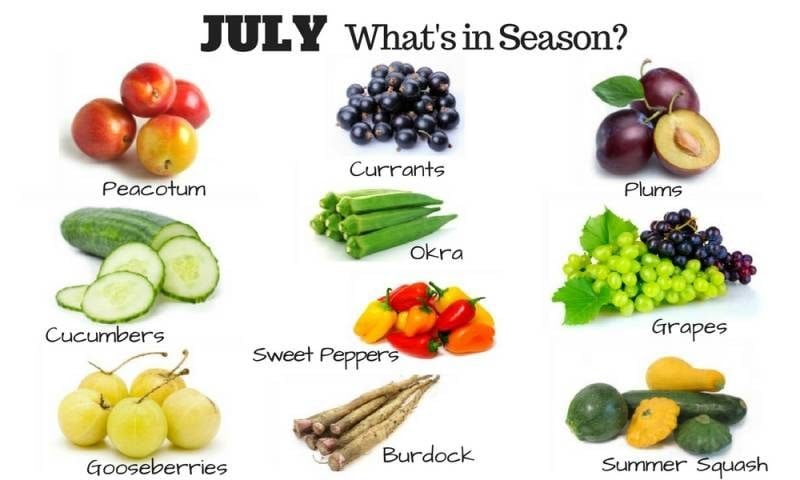
-
Burdock
Popular in Asian cultures, this root vegetable can be eaten like a potato or substituted for artichokes.
-
Okra
Gumbo is only complete with okra. Buy it fresh during the summer for optimal flavor and nutrition.
-
Sweet Peppers
More commonly called bell peppers, these crunchy vegetables make a wonderful addition to your summer plate.
-
Cucumbers
The cool, refreshing taste of summer arrives in the form of the cucumber, which reaches its season now.
-
Summer Squash
Summer squash is a name that covers a wide variety of squashes. These include zucchini, which grows best during the warm months of summer.
-
Gooseberries
Available from May to August, gooseberries reach their peak in July and are at their best for picking then.
-
Currants
A somewhat sour fruit that may require a touch of sweetness from honey or sugar, currants reach their season in the hot summer months.
-
Grapes
Possibly the oldest cultivated fruit in the world, grapes are available at their freshest from July to November.
-
Peacotum
A hybrid between a peach, apricot, and plum, these sweet fruits are available only in July and August.
-
Plums
A sweet fruit which makes an excellent jam, plums are available during the heat of summer.
July
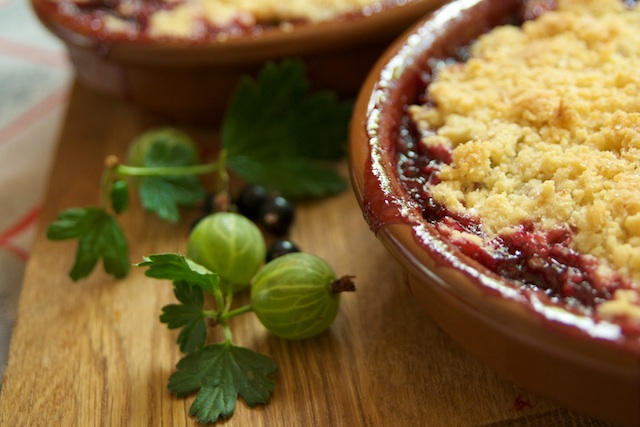
Shopping Tips
- Many areas have berry farms, and a trip to one to pick your own may save you a bundle on fresh berries.
- Summer squash become bitter the larger they get, so choose produce that are eight inches or smaller.
- Look for firm plums that have just a little give to them.
Click here to go back to the top and see the list of anchor links.
August Fruits and Vegetables
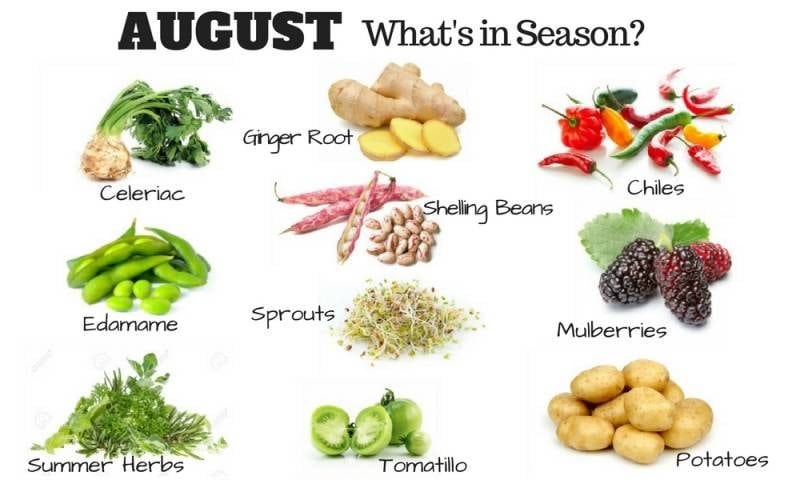
-
Edamame
More commonly known as soybeans, these nutritious beans are ready to harvest in August.
-
Tomatillo
A key ingredient in salsa and many other Latin American dishes, the tomatillo is available during the summer and early fall months.
-
Celeriac
Also called celery root, these potato-shaped vegetables reach season during the warmer months.
-
Ginger Root
Native to India and common in many Asian dishes, ginger root begins its season in August.
-
Potatoes
A hardy root vegetable, potatoes are in season from June to August.
-
Chiles
A harbinger of late summer, chili peppers are in season until August.
-
Mulberries
A delicate berry with a short shelf life, you'll have to jump to your closest farmer's market to get them.
-
Shelling Beans
Not to be confused with green beans, shelling beans are named thus as you must remove the outer pod before you can eat the seeds inside.
-
Sprouts
A catch-all name for the various types available, sprouts make an excellent addition to your favorite summer salad or sandwich.
-
Summer Herbs
A necessity for any kitchen, herbs such as rosemary are grown and harvested during this time.
August
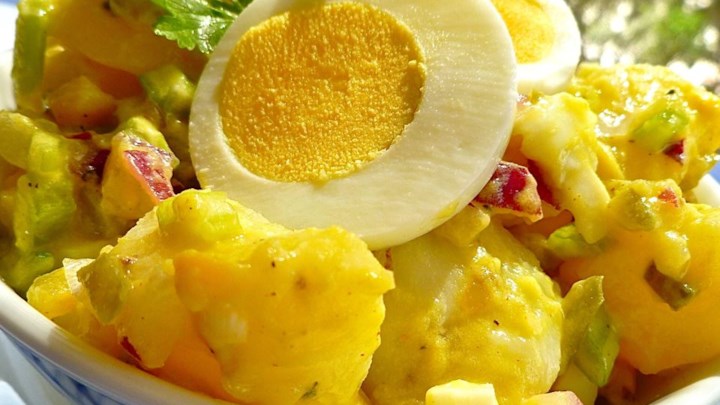
Shopping Tips
- Edamame is another food item that keeps well when frozen.
- Sprouts should be kept cold, no warmer than 40F.
- To keep your potatoes fresh, store them in a cool dark place.
Click here to go back to the top and see the list of anchor links.
Fall
Bring on the pumpkin and apples! The official harvest season is here and with it some of our favorite holiday flavors.
September Fruits and Vegetables
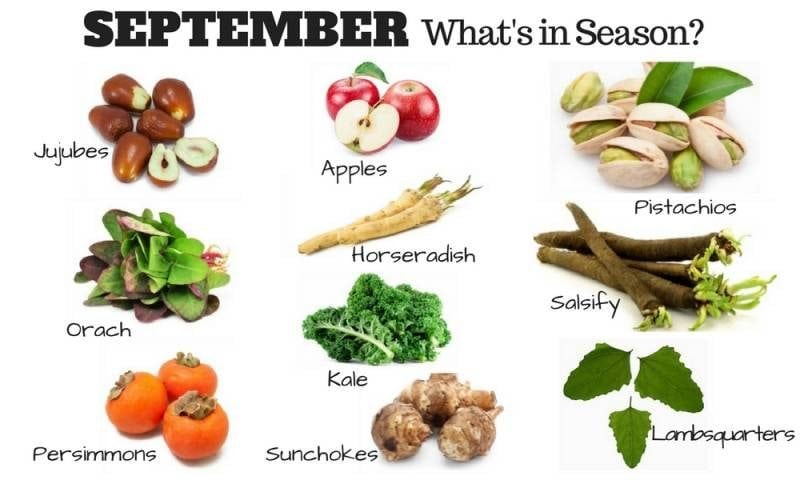
-
Lambsquarters
No, not a leg of lamb: lambsquarter is a green similar to spinach or chard.
-
Salsify
Salsify is a name used to describe two root vegetables, both of which can lend a rich flavor to traditional meals such as soup or mashed potatoes.
-
Apples
Although apples can be found out of season in the market, they are at their best during this time of year.
-
Persimmons
A fall fruit, persimmons are available from September to February.
-
Pistachios
Technically a nut, pistachios are full of antioxidants and make a very healthy snack.
-
Sunchokes
Also known as Jerusalem artichokes, these tubers are native to North America and are available only during the cooler months of the year.
-
Orach
The most commonly found orach cultivar is the red orach, which is referred to as French Spinach.
-
Kale
My kids have an obsession with kale chips, and given the health benefits of this leafy green, I'm not likely to argue with them.
-
Jujubes
An excellent source of vitamin C, jujubes are only available during the early fall.
-
Horseradish
This root vegetable adds a kick to any dish you put it in, very similar to wasabi.
September
Shopping Tips
- Buy kale organically, as it may be contaminated otherwise.
- Store unwashed horseradish in a plastic bag in the fridge.
- Jujubes can be stored in the fridge indefinitely.
Click here to go back to the top and see the list of anchor links.
October Fruits and Vegetables
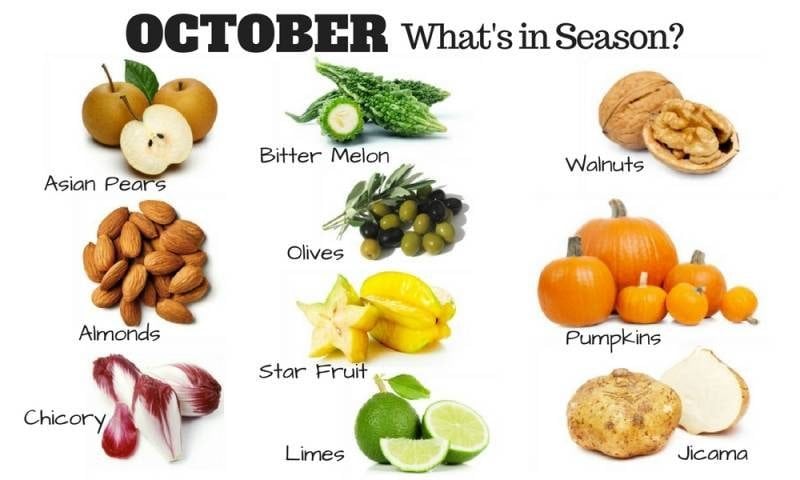
-
Jicama
Also called the Mexican yam, this vegetable makes a crunchy addition to fall salads.
-
Bitter Melon
Not to be confused with the similar looking cucumber, bitter melon is a bit of an acquired taste; the name is a giveaway. But it's very nutritious.
-
Walnuts
The oldest nut known to man, walnuts are only in season this month.
-
Star Fruit
Named for its shape, star fruit is available now. I suggest trying it if you can—it's delicious!
-
Asian Pears
Juicy and crisp, Asian pears are just a bit sweet.
-
Almonds
Harvested in the early fall, almonds can be found year-round in farmer's markets.
-
Pumpkins
No October food list could be complete without pumpkin! Head to your nearest pumpkin patch to find the freshest available.
-
Limes
Key limes are probably the most popular of the limes out there. Lucky for us, they're available now.
-
Chicory
Technically an herb, chicory is available now to lend a unique flavor to your fall dishes.
-
Olives
My kids call olives “finger caps” and turn them into little finger puppets. I prefer to eat them in pasta. And right now is a great time to get them at their freshest.
October
Shopping Tips
- When selecting pumpkins, make sure your pumpkin is completely orange.
- Chicory does not freeze well, so be sure to store it in the fridge instead.
- Store almonds in a cool, dry place.
Click here to go back to the top and see the list of anchor links.
November Fruits and Vegetables
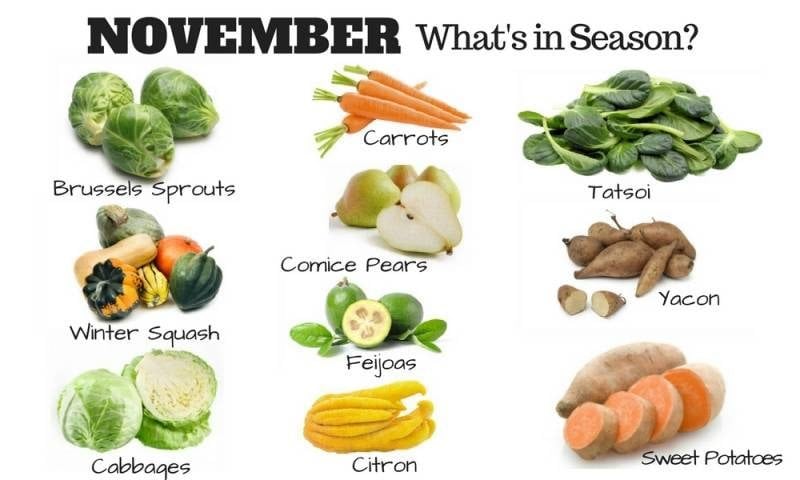
-
Sweet Potatoes
I can't remember a Thanksgiving without sweet potatoes. No wonder, as these tubers are harvested during this season.
-
Brussels Sprouts
My kids are not the biggest fans of Brussels sprouts, but now that I know when to get them at their freshest, we may just give them a second chance.
-
Feijoas
Also called pineapple guava, these sweet tropical fruits are only around in November and December.
-
Tatsoi
A mustard flavored green, tatsoi are ready now for you to try in your next soup.
-
Yacon
Also called the Peruvian ground apple, yacons are similar in flavor to jicamas.
-
Comice Pears
A large, round pear with a short neck, Comice pears come into season in November and December.
-
Citron
A citrus fruit used mainly for its zest, citron is available for your holiday baking now.
-
Winter Squash
Acorn, butternut, carnival, and other squashes fall under the catch-all title of winter squash, a type which is only available during the cooler months.
-
Cabbages
Cabbage is at its best during this time of year, making it a go-to ingredient for many holiday tables.
-
Carrots
A versatile root vegetable, carrots make an excellent addition to many meals.
November
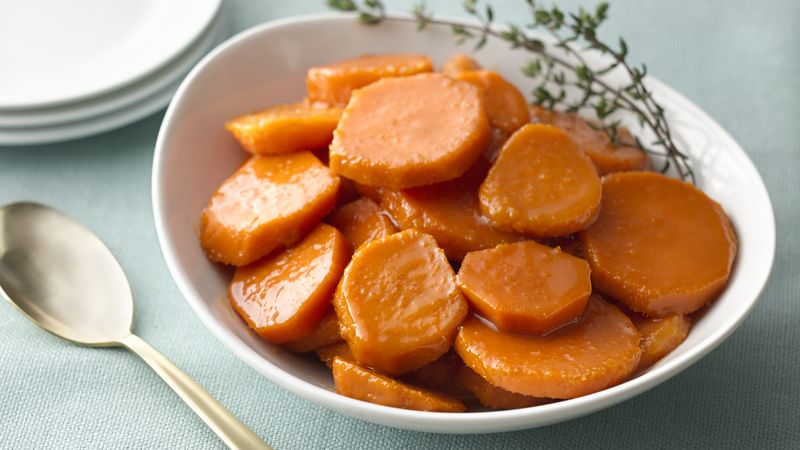
Shopping Tips
- Carrots lose moisture through their leafy tops, so if yours still have them attached, be sure to cut them off before storing.
- Sweet potatoes spoil fast, so be sure to use or freeze them quickly.
- Avoid yellowing leaves on your Brussels sprouts, as this can indicate that spoiling has begun.
Click here to go back to the top and see the list of anchor links.
There are more produce items than what I've listed here, of course, but I hope this is a good starting point for you. Diet is such an important part of our lives and can have a profound impact on our health. That's why it's so important to know what food items are in season, to get the most of their nutrients as possible. Plus, you'll avoid falling in a rut when meal planning, as you have new ingredients to use each season.




